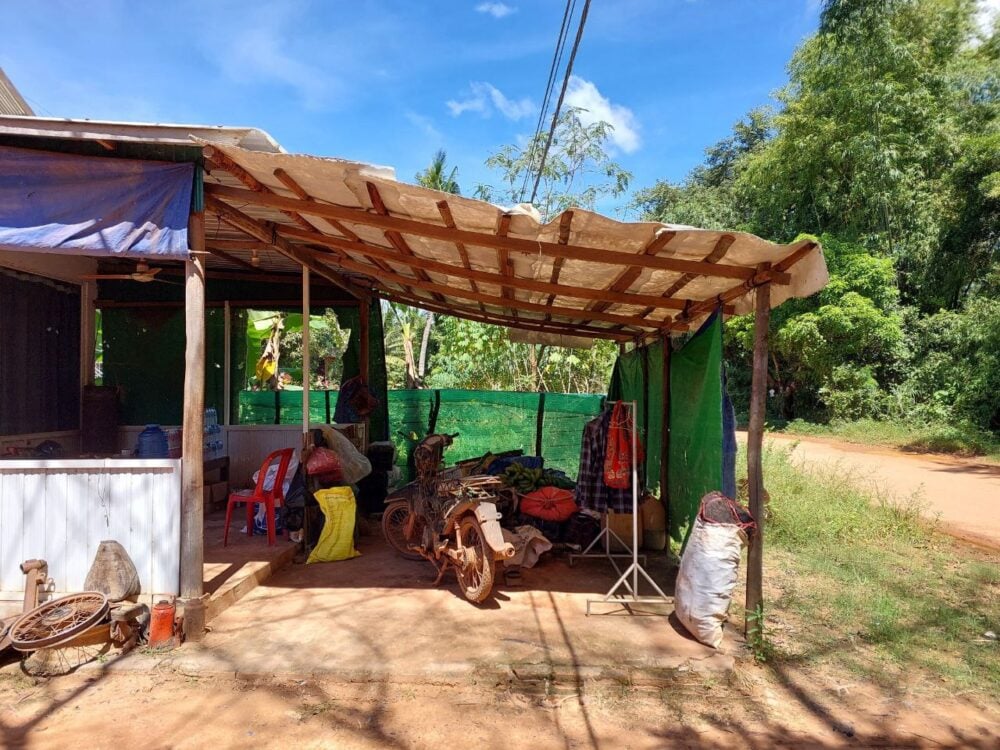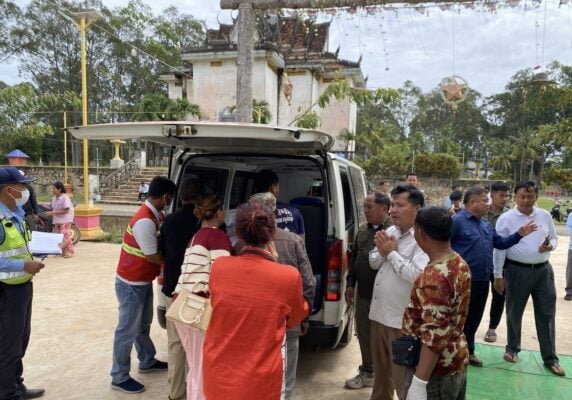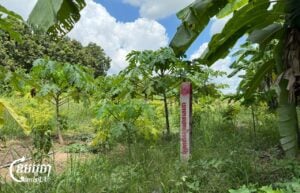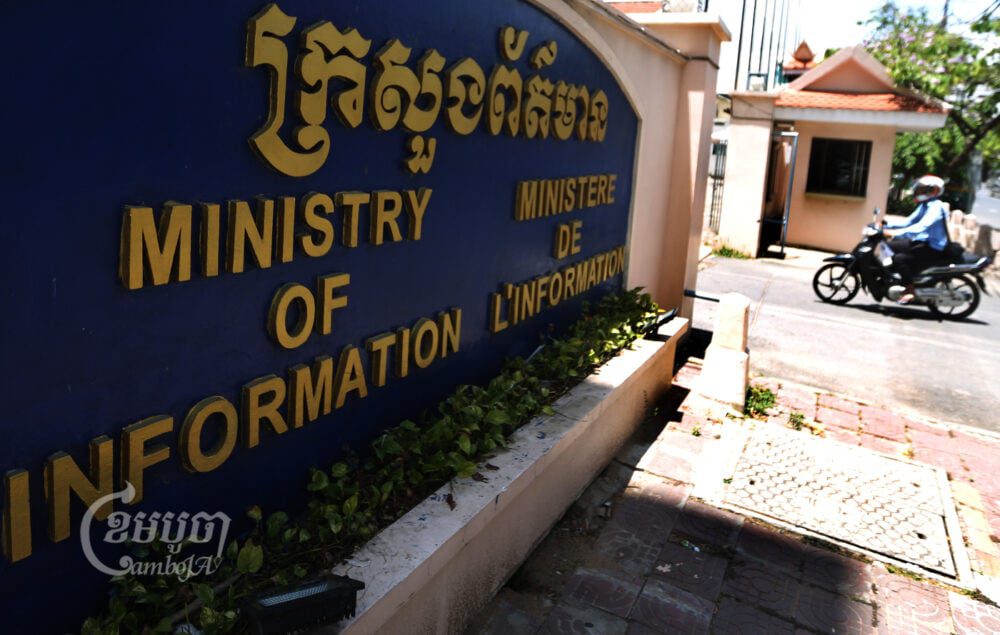A lawsuit has been filed by APSARA National Authority against seven villagers, including a commune police chief, who live around Angkor Wat, a UNESCO World Heritage Site, for allegedly inciting and obstructing public work in August.
Two separate court summons issued against the villagers were obtained by CamboJA One summon was against four villagers, including the local police officer, who allegedly obstructed public work and intentionally caused damage and violence. Another summon was issued to the villagers for allegedly inciting other villagers.
On August 8, hundreds of villagers protested against an attempt by APSARA to demolish allegedly illegal structures after issuing a notice in Prasat Bakong district’s Meanchey commune.
Although the authority failed to demolish the structures, the villagers have been restricted by APSARA from constructing additional structures in front of their house or fixing their roofs.
“I don’t know why they have filed a suit [against me]. I only went to see [the protest],” said 38-year-old Var Chamnab, who is being sued along with three other villagers by APSARA.
“I wasn’t the only one [there] on that day … hundreds of people protested,” he said, adding that he was aware that villagers do not have permission to build, but that they had sought for permission several times but were denied.
Rolous commune police chief Rai Vanna said he cannot offer any details or comment as yet as he has not testified in court as to what he witnessed during the protest. He was supposed to give evidence on October 18 but it was postponed.
He said he had gone to the protest to monitor the situation and ensure public order.
“On behalf of the authorities, we have to give evidence on the case – villagers who were protesting – but the questioning has been deferred. So, I can’t say more as I am an official and I need to get approval from my boss before I can say anything,” Vanna said.
A villager, 36-year-old Sok Pov, was accused of incitement for allegedly posting APSARA’s notice on the removal of “illegal” structures in Bangkorng village on August 14 and 15. He is alleged to have asked villagers living inside and outside the village to “please join the protest”.
“I just posted [the notice] to inform people to come and appeal against the demolition,” he told the court when questioned on October 23, before being allowed to return home.
“I think it [the legal suit] was unreasonable. It is like restricting our freedom of expression when [all we did was] post the notice,” Pov said.
He said villagers living in Zone 2, which is a world heritage site, are not allowed to build new structures and extend the front portion of their house as it would impact the Angkor temples.
“There are a lot of difficulties [restrictions] … we can’t fix our house roof or build any extension in front. Within the authorities’ land, there are a lot of restrictions.
“They require us to seek permission [for construction] but when we request, they do not give us permission,” Pov said.
Earlier, a letter was sent by APSARA to village chiefs and representatives to inform them about the demolition of illegal structures, such as new shelters or cottages and new additions to front portions of old houses, from August 14 to 15, 2023.
APSARA spokesperson Long Kosal confirmed that his officials had “demolished” several illegal structures and houses but he could not specifically identify which ones needed to be removed.
“[New] constructions are not allowed within the world heritage site and they would need to get permission to build them. When it’s built without permission, it is [an] illegal [structure],” Kosal said.
“But, it doesn’t mean that when you apply for permission you will get an approval,” Kosal said, adding that there are legal requirements and conditions that should be satisfied when applications are reviewed.
Before the authority removed the structures, APSARA issued a notice in advance, he confirmed, but denied that there were restrictions on the rights of people who live within the world heritage sites.
“I think that some of our people have different levels of knowledge about the law. We can review how many people are living at the world heritage site, who are allowed to to fix houses or remove old houses and build new houses,” he said.
“We have to review the situation as a whole, not by looking on a case by case basis,” Kosal said.
NGO Licadho rights coordinator Ing Kongchet, who investigated the issue, called on the court officials to drop the charges against the villagers. He also urged UNESCO to intervene to protect the fundamental rights of the villagers and improve their living conditions.
“It is an issue that violates human rights. We appeal to APSARA and UNESCO to reconsider this case. APSARA has restricted people’s rights in requesting to fix or build houses.
“We support conservation but people’s livelihoods are important as well. People need security and safety. If their houses have no gates or toilets, and their roofs leak when it rains, they should give permission to fix it,” Kongchet said.
Meanwhile, a spokesperson with the UNESCO World Heritage Center asserted that UNESCO has “never requested, supported, or was a party to the relocation program” and that any questions relating to it should be conveyed to the national authority.
In response to CamboJA’s questions via email on Friday evening, the spokesperson said for all the sites in the world, UNESCO underscores that conservation measures decided by the authorities “must necessarily involve, take into account the opinion and respect the rights of local communities, and comply with human rights”.
The importance of the inclusion of local communities has been officially included in the World Heritage Convention’s Operational Guidelines since 2015.
According to the spokesperson, the center has already conveyed the concerns raised by international NGOs regarding the relocation program to the Cambodian state party and the World Heritage Committee, a 21-member intergovernmental body. (A state party is a country, in this case Cambodia, which has adhered to the World Heritage Convention).
At its last session in September 2023, the committee requested the state party to “take into consideration the living conditions and the rights of local communities and inhabitants affected by these relocations”, the spokesperson mentioned.
The state party was also requested to submit an updated report on the state of conservation of the property demonstrating the implementation of its suggestions to the UNESCO World Heritage Centre, by December 1, 2024.
The spokesperson reminded that despite UNESCO’s resolute commitment to rights-based management of World Heritage Sites including the inclusion of rights holders and local communities in the conservation strategies of the properties, it does not have the mandate to impose measures on member states. “The conservation and management of World Heritage Properties are under the sole authority of the concerned state parties, which are sovereign over their territories.”
In the meantime, Siem Reap provincial court spokesperson Yin Srang confirmed that the court has postponed the questioning of the four villagers, including the policeman and that the next date has not been fixed yet.
Srang claimed that he does not know who the prosecutor of the case is, when asked to comment on those who have been questioned.
Last week, CamboJA reported that 700 villagers from seven villages in Pouk district and Siem Reap City protested against APSARA for attempting to demolish the illegal structures.
Kosal said there are about 10,000 families who volunteered to move to relocation sites, while the Peak Sneng site remains under construction.
Update: This story was updated on November 4 at 10:40 a.m. ICT to include comments received from UNESCO World Heritage Center after publication.











